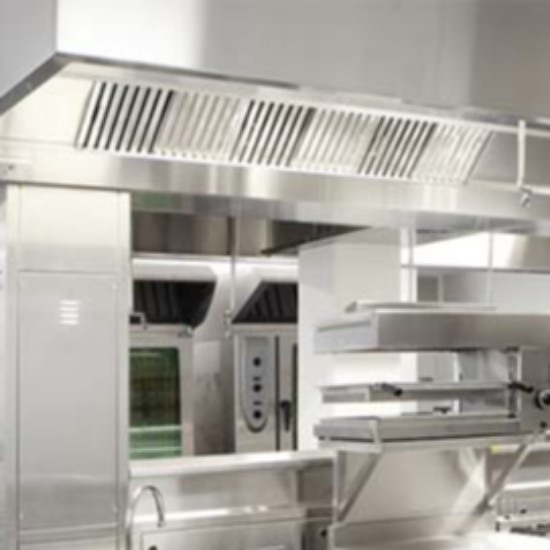
Cooking is the leading cause of death and destruction from fires in the U.S. Cooking fires account for $16.4 million in property damage annually. Additionally, cooking was the leading cause of fire in all healthcare facilities (nursing home, hospital, mental health facility, clinic or doctors office) according to NFPA US Structure Fires in Health Care Properties Fact Sheet (download it here). Keeping up with your required kitchen hood system inspections is an important part of protecting lives and your facility.
Kitchen hood suppression systems are designed, tested, and approved to provide fire protection for commercial kitchen cooking appliances, hoods, and ducts.
Kitchen hood systems have an efficient, automatic detector response that acts fast to suppress flames. Kitchen hood systems eliminate the need for a constant supply of the suppressing agent and manual shut off of the appliance’s gas and electric, while blocking any danger of a violent reaction that may spread flame or spill cooking oil.
Facilities that should have kitchen hood systems:
- Gourmet Restaurants
- Sports Complexes
- Fast-Food Chains
- Retail Food Courts
- Convenience Stores
- Hotel Kitchens
- Diners
- School Cafeterias
- Food Service Kitchens
Kitchen hood systems will extinguish fires caused by the following:
- Deep Fryers
- Ranges
- Griddles
- Char-Broilers
- Woks
- Upright Boilers
- Chain-Broilers
- Filters
- Plenum Chambers
- Hoods
- Ducts
How Do Kitchen Hood Systems Work?
When a fire starts in a protected area, heat sensitive links activate the kitchen hood system. The system stops the cooking appliance’s gas and electric supply. An extinguishing agent releases through nozzles and onto the appliances, plenum and duct.
At the first sign of fire, remember to evacuate the building and call 911. Stand by with a K class extinguisher just in case the system fails to act or a re-flash occurs.
Types of Restaurant Fire Suppression Systems
Wet Chemical Systems
Wet chemical systems are the most commonly used kitchen hood system. The wet chemical agent suppresses fire by cooling and reacting chemically to produce a foam layer on the grease. The foam seals combustible vapors, stopping the flames from re-igniting.
Dry Chemical Systems
Dry chemical systems were used to extinguish flammable liquid fires involving live electrical equipment. Dry chemical interrupts the chemical reaction of fire by removing the oxygen from the source. When the multipurpose dry chemical is discharged, the agent leaves a residue on the burning material. The residue seals the material from the oxygen to suffocate the fire. Unfortunately, because deep fryers are much more insulated than in the past, dry chemical systems are not capable of extinguishing kitchen fires. UL 300 Systems are recommended as a good replacement for dry chemical kitchen hood systems.
UL 300 Wet System
UL 300 systems use wet chemicals to smother the fire (like dry chems) and to prevent re-ignition by cooling the flammable liquids (unlike dry chems). The UL 300 standard represents the heightened suppression innovation to accommodate new, hotter cooking methods and is currently the most effective way to suppress a kitchen hood fire. If you are due to change your kitchen hood system soon, most states will require you to update to a UL 300 system.
Living and Caring for Your Restaurant Fire Suppression System
Have a certified kitchen hood system professional inspect your kitchen hood system every 6-months and immediately after any major hood/duct cleaning. The system should be inspected overall and tested to verify that it is fully operational. Keep in mind that menu, preparation, and layout may require an update to your system. Any updates, again, require a professional.
While a professional should service, test, inspect, recharge or repair a system, NFPA asks system owners to perform a monthly inspection. This inspection is for visible problems with the kitchen hood system.
Check the following during your monthly visual inspection:
- The extinguishing system is in its proper location.
- The manual actuators are unobstructed.
- The tamper indicators and seals are intact.
- The maintenance tag or certificate is in place.
- No obvious physical damage or condition exists that might prevent operation.
- The pressure gauge(s), if provided, is in operable range.
- The nozzle blow-off caps are intact and undamaged.
- The hood, duct, and protected cooking appliances have not been replaced, modified, or relocated.
Supplement Your Kitchen Hood System
K-Class fire extinguishers are used to protect against kitchen hazards without leaving residue. These extinguishers are a great supplement to kitchen hood systems and should be present in any commercial cooking environment.
A1 is a leading expert on the latest technology in life safety. To find out more information or to ask a question, click here or call us at 1-800-859-6198.
